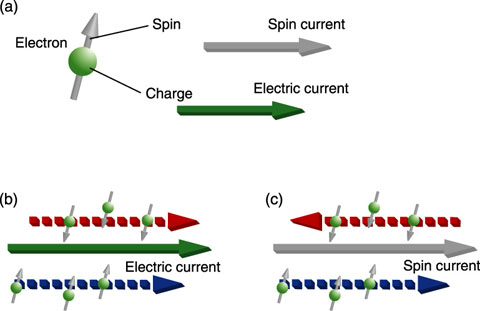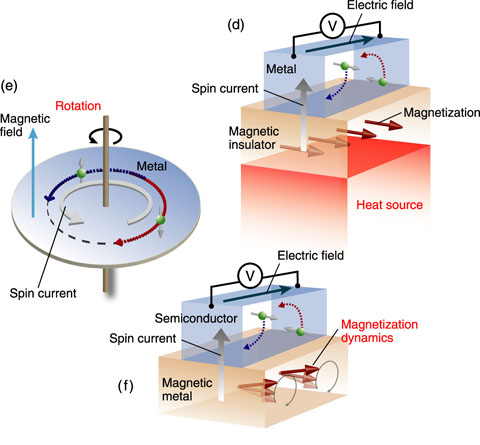
Fig.6-3 Electron’s charge and spin

Fig.6-4 New methods for generating spin currents
Electronics is indispensable in our daily life in the information society. As the next-generation technology, “spintronics” has attracted global interest. We have devised new methods for generating “magnetic flow,” which is the main ingredient of spintronics[1]∼[3].
As the name implies, electronics is the art of controlling electrons in solids. The electron has two aspects: “charge” and “spin” (Fig.6-3). The charge is the origin of electricity, and its flow leads to an electric (charge) current. On the other hand, the spin gives rise to magnetism and its flow is called spin current. To date, developments in the field of electronics have been based solely on charge currents. Spintronics aims to improve the current technology by harnessing both the currents equally. It has been recognized, however, that it is quite a hard task to utilize spin currents, unlike the case of charge currents. In this context, we have discovered new principles for generating spin currents.
First, we have found that a spin current can be generated by producing a temperature gradient in a magnetic insulator[1]. The thermally induced spin current is converted to an electric current via the inverse spin Hall effect in an attached metal (Fig.6-4(d)). This finding can facilitate the development of new architecture for thermoelectric devices.
Second, we theoretically predict that a rotating body (Fig.6-4(e)) can produce a spin current, by combining general relativity and quantum mechanics[2]. This finding opens up opportunities for the direct conversion of quantum mechanical rotation into its classical counterpart, which can lead to inventions of nanoscale motors.
Third, using magnetization dynamics induced by ferromagnetic resonance (Fig.6-4(f)), we have succeeded in injecting spin currents into semiconductors with a very high efficiency (103 times larger than before)[3]. Since semiconductors are basic materials for conventional electronic devices, the impact of this finding on the spintronics community is astonishingly large.
A variety of such high-efficiency methods of spin current generation can contribute to the advancement of basic science, which is necessary for building an energy-saving society in the near future.